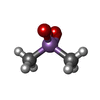[English] 日本語
 Yorodumi
Yorodumi- PDB-6kbl: Structure-function study of AKR4C14, an aldo-keto reductase from ... -
+ Open data
Open data
- Basic information
Basic information
| Entry | Database: PDB / ID: 6kbl | ||||||
|---|---|---|---|---|---|---|---|
| Title | Structure-function study of AKR4C14, an aldo-keto reductase from Thai Jasmine rice (Oryza sativa L. ssp. Indica cv. KDML105) | ||||||
 Components Components | Aldo-keto reductase | ||||||
 Keywords Keywords |  OXIDOREDUCTASE / Aldo-keto reductase (AKR) / OXIDOREDUCTASE / Aldo-keto reductase (AKR) /  Aldehyde reductase / Aldehyde reductase /  Aldose reductase / rice AKR / AKR4C14 Aldose reductase / rice AKR / AKR4C14 | ||||||
| Function / homology |  Function and homology information Function and homology information | ||||||
| Biological species |   Oryza sativa subsp. indica (long-grained rice) Oryza sativa subsp. indica (long-grained rice) | ||||||
| Method |  X-RAY DIFFRACTION / X-RAY DIFFRACTION /  SYNCHROTRON / SYNCHROTRON /  MOLECULAR REPLACEMENT / Resolution: 1.7 Å MOLECULAR REPLACEMENT / Resolution: 1.7 Å | ||||||
 Authors Authors | Songsiriritthigul, C. / Narawongsanont, R. / Guan, H.H. / Chen, C.J. | ||||||
 Citation Citation |  Journal: Acta Crystallogr D Struct Biol / Year: 2020 Journal: Acta Crystallogr D Struct Biol / Year: 2020Title: Structure-function study of AKR4C14, an aldo-keto reductase from Thai jasmine rice (Oryza sativa L. ssp. indica cv. KDML105). Authors: Songsiriritthigul, C. / Narawongsanont, R. / Tantitadapitak, C. / Guan, H.H. / Chen, C.J. #1:  Journal: Protein J. / Year: 2017 Journal: Protein J. / Year: 2017Title: Characterization of AKR4C15, a Novel Member of Aldo-Keto Reductase, in Comparison with Other Rice AKR(s). Authors: Auiyawong, B. / Narawongsanont, R. / Tantitadapitak, C. | ||||||
| History |
|
- Structure visualization
Structure visualization
| Structure viewer | Molecule:  Molmil Molmil Jmol/JSmol Jmol/JSmol |
|---|
- Downloads & links
Downloads & links
- Download
Download
| PDBx/mmCIF format |  6kbl.cif.gz 6kbl.cif.gz | 80.7 KB | Display |  PDBx/mmCIF format PDBx/mmCIF format |
|---|---|---|---|---|
| PDB format |  pdb6kbl.ent.gz pdb6kbl.ent.gz | 58.1 KB | Display |  PDB format PDB format |
| PDBx/mmJSON format |  6kbl.json.gz 6kbl.json.gz | Tree view |  PDBx/mmJSON format PDBx/mmJSON format | |
| Others |  Other downloads Other downloads |
-Validation report
| Arichive directory |  https://data.pdbj.org/pub/pdb/validation_reports/kb/6kbl https://data.pdbj.org/pub/pdb/validation_reports/kb/6kbl ftp://data.pdbj.org/pub/pdb/validation_reports/kb/6kbl ftp://data.pdbj.org/pub/pdb/validation_reports/kb/6kbl | HTTPS FTP |
|---|
-Related structure data
| Related structure data |  3h7uS S: Starting model for refinement |
|---|---|
| Similar structure data |
- Links
Links
- Assembly
Assembly
| Deposited unit | 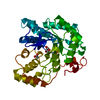
| ||||||||
|---|---|---|---|---|---|---|---|---|---|
| 1 |
| ||||||||
| Unit cell |
|
- Components
Components
| #1: Protein |  Mass: 34725.684 Da / Num. of mol.: 1 Source method: isolated from a genetically manipulated source Source: (gene. exp.)   Oryza sativa subsp. indica (long-grained rice) Oryza sativa subsp. indica (long-grained rice)Gene: AKR2, OsI_04428 / Plasmid: PET28B(+) / Production host:   Escherichia coli BL21(DE3) (bacteria) / References: UniProt: B8AC38 Escherichia coli BL21(DE3) (bacteria) / References: UniProt: B8AC38 |
|---|---|
| #2: Chemical | ChemComp-CAC /  Cacodylic acid Cacodylic acid |
| #3: Chemical | ChemComp-ACT /  Acetate Acetate |
| #4: Chemical | ChemComp-GOL /  Glycerol Glycerol |
| #5: Water | ChemComp-HOH /  Water Water |
| Has ligand of interest | N |
| Sequence details | The amino acid residue translated from gene is Glu74. But the amino acid that be properly rebuilt ...The amino acid residue translated from gene is Glu74. But the amino acid that be properly rebuilt in the map is Ala74 (appeared in the PDB Coordinates), owing to the disorder of its side chain. |
-Experimental details
-Experiment
| Experiment | Method:  X-RAY DIFFRACTION / Number of used crystals: 1 X-RAY DIFFRACTION / Number of used crystals: 1 |
|---|
- Sample preparation
Sample preparation
| Crystal | Density Matthews: 2.12 Å3/Da / Density % sol: 42.1 % / Description: Rectangular morphology |
|---|---|
Crystal grow | Temperature: 277 K / Method: batch mode / pH: 6.5 Details: 0.2 M sodium acetate, 0.1 M sodium cacodylate pH 6.5, 30%(w/v) PEG 8000 |
-Data collection
| Diffraction | Mean temperature: 110 K / Ambient temp details: Nitrogen stream / Serial crystal experiment: N |
|---|---|
| Diffraction source | Source:  SYNCHROTRON / Site: SYNCHROTRON / Site:  NSRRC NSRRC  / Beamline: BL13B1 / Wavelength: 1 Å / Beamline: BL13B1 / Wavelength: 1 Å |
| Detector | Type: ADSC QUANTUM 315 / Detector: CCD / Date: Jul 21, 2016 |
| Radiation | Monochromator: DCM / Protocol: SINGLE WAVELENGTH / Monochromatic (M) / Laue (L): M / Scattering type: x-ray |
| Radiation wavelength | Wavelength : 1 Å / Relative weight: 1 : 1 Å / Relative weight: 1 |
| Reflection | Resolution: 1.7→30 Å / Num. obs: 33541 / % possible obs: 99.1 % / Redundancy: 5.6 % / Rmerge(I) obs: 0.275 / Net I/σ(I): 18.28 |
| Reflection shell | Resolution: 1.7→1.73 Å / Redundancy: 4.9 % / Rmerge(I) obs: 0.073 / Mean I/σ(I) obs: 4.53 / Num. unique obs: 1639 / % possible all: 98.2 |
- Processing
Processing
| Software |
| ||||||||||||||||||||
|---|---|---|---|---|---|---|---|---|---|---|---|---|---|---|---|---|---|---|---|---|---|
| Refinement | Method to determine structure : :  MOLECULAR REPLACEMENT MOLECULAR REPLACEMENTStarting model: 3H7U Resolution: 1.7→29.24 Å / Cross valid method: THROUGHOUT
| ||||||||||||||||||||
| Displacement parameters | Biso mean: 20.936 Å2 | ||||||||||||||||||||
| Refinement step | Cycle: LAST / Resolution: 1.7→29.24 Å
| ||||||||||||||||||||
| LS refinement shell | Resolution: 1.7→1.74 Å
|
 Movie
Movie Controller
Controller


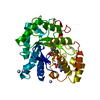


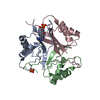

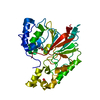



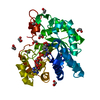
 PDBj
PDBj




